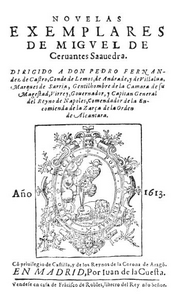Rinconete y Cortadillo facts for kids
Quick facts for kids "Rinconete y Cortadillo" |
|
|---|---|

1613 book cover
|
|
| Author | Miguel de Cervantes |
| Original title | "Novela de Rinconete y Cortadillo" |
| Country | Spain |
| Language | Spanish |
| Genre(s) | Picaresque short story |
| Published in | Novelas Ejemplares |
| Publication date | 1613 |
| Preceded by | "El amante liberal" |
| Followed by | "La española inglesa" |
"Rinconete y Cortadillo" (or "Novela de Rinconete y Cortadillo") is one of the twelve short stories included in Novelas Ejemplares, by Spanish writer Miguel de Cervantes. It describes the comical adventures of two petty criminals as they travel to Seville and are then taken in by the city's thieves' guild. Seville at the time was a rich city with marked social contrasts, being the entrepôt of Spain and the new world of the Americas.
Plot
Two young men, Rincón and Cortado, meet at a roadside inn. They boastfully share stories of robbing and cheating fellow travelers that make it clear that they are both pícaros--wandering petty criminals--and agree to continue on together. They travel to Seville, where their petty crimes bring them to the attention of the city's thieves' guild. Rincón and Cortado are taken in by the guild, and in the second half of the story, they observe its comical organization and antics under its leader, Monipodio. As a sign of the pair's absorption into the syndicate, Monipodio gives them the affectionate nicknames of the story's titles, Rinconete y Cortadillo.
History and authorship
In the words of Cervantes scholar Juergen Hahn, "the issue of the Rinconete's authorship has been a sensitive one ever since ... 1788", when a copy of the story was found that was attributed to Cervantes' contemporary Licenciado Porras de la Camara. Cervantes refers to the story by name in Don Quixote Book I, published in 1605, and metafictionally attributes the story to himself. However, the actual story was apparently not published until 1613, eight years later. In the 1980s and '90s, scholar E. T. Aylward argued that "Rinconete" and "El celoso extremeño" were both plagiarized by Cervantes. however, these arguments were largely debunked by later analysis by philologist Geoffrey Stagg, whose work cast serious doubt on the authenticity of the Porras manuscript.
Hahn theorizes that Cervantes originally intended "Rinconete" as a tale-within-a-tale to be included in the Quixote itself, in the position that "El curioso impertinente" instead holds.
See also
 In Spanish: Rinconete y Cortadillo para niños
In Spanish: Rinconete y Cortadillo para niños

